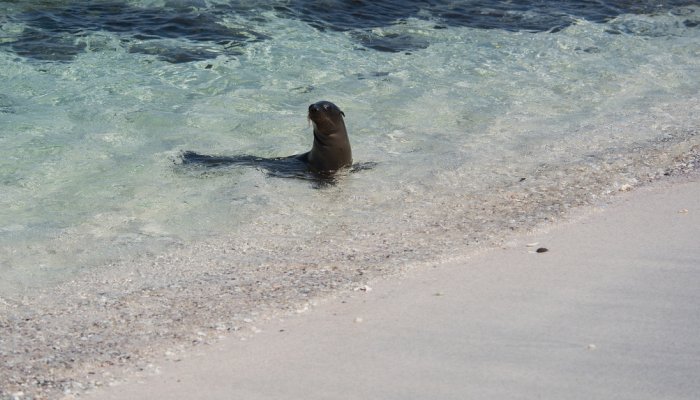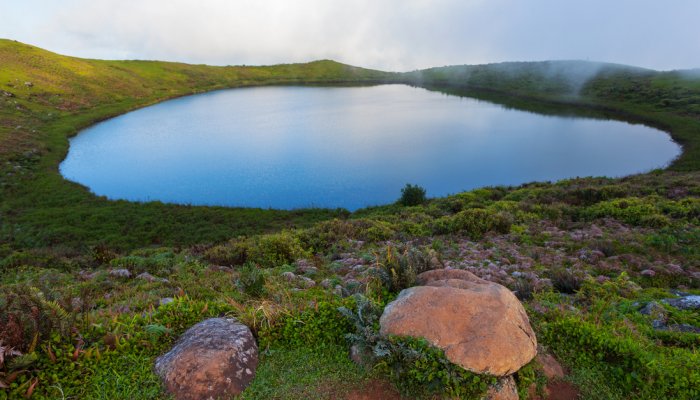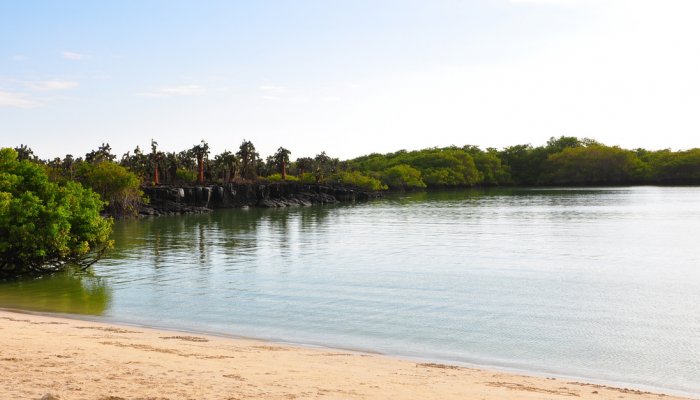BLACK TURTLE COVE
Found on the northern shores of Santa Cruz, Black Turtle cove is a mangrove-lined inlet accessible only by panga or dinghy. It’s a popular destination site for sea turtles, golden and spotted eagle rays, and black-tip and white-tip reef sharks—in particular the young marine life. Lava herons, yellow warblers, and pelicans can also be found perched in the trees. If you're interested in cruise adventures, take a look at the options we have to offer.
PUNTA PITT
Located on the far eastern coast of San Cristóbal Island, Punta Pitt is known for its stunning views and wildlife. Visitors are greeted by a yellow-sand beach and the cacophonous barking of the bachelor colony of Galápagos sea lions who live there. From the bay, a trail leads up a rocky hill with panoramic views of the bay below. The scrubland is colorful at Punta Pitt, with saltbush, Palo Santo trees, cacti, and vivid carpets of red vesuvius.
Punta Pitt’s main attraction is its boobies. Visitors have the opportunity to see all three types of boobies at Punta Pitt: Red-footed boobies, blue-footed boobies, and Nazca boobies. While blue-footed boobies build their nests on the ground, red-footed booby nests can be seen in small trees and bushes. In contrast, Nazca boobies are usually seen flying above the rocky hill. Two species of frigatebirds can also be found at Punta Pitt, along with Storm Petrels and Swallow-tailed gulls. Book a tour on our Galápagos Islands Cruise to experience boobie-watching for yourself.Come and join us! Book a Galapagos adventure to experience all of the jaw-dropping views for yourself. Kayak along Galapagos shores and even camp on the beach on our Galapagos Kayaking Expedition.

ISLOTE MOSQUERA
Mosquera Islet stands in the channel between Baltra and North Seymour. Flat, coated in white sand, and surrounded by coral reefs, Mosquera was formed by geological uplift.
It’s an excellent snorkeling and diving site, with plenty of marine life swimming beneath the sea. However, it’s most well known as a sea lion rookery, and newly born sea lion pups can be seen there in June and July.
Besides the rampant population of sea lions, boobies, brown pelicans, lava gulls, and yellow crowned herons can be found throughout the island. There have also been sightings of orcas popping up for a sea lion snack on Islote Mosquera.

EL JUNCO LAGOON
One of the few permanent freshwater lakes in the Galápagos, El Junco Lagoon remains a draw to both people and wildlife. El Junco lies in the San Cristóbal highlands, settled into a caldera from which visitors can view the peak of Cerro San Joaquin as well as Punta Pitt. Geologists believe that El Junco Lagoon has been around since the last northern ice age
White-cheeked pintail ducks, common gallinules, and Chatham mockingbirds are known to enjoy the freshwater lagoon and its surrounding environment of tree ferns and Miconia bushes. El Junco is also one of the best places to catch sight of Great and Magnificent frigatebirds who enjoy bathing in the water and preening their heavy feathers.
FUN FACT:
El Junco Lagoon’s freshwater drew WWII soldiers to its shores alongside the birds, despite having to travel such a long distance to get there.

TORTUGA BAY (TURTLE BAY)
As the name suggests, Tortuga Bay is named for the black turtles that nest throughout the white sand beach. However, it’s for it’s heady calm that Tortuga Bay is known as one of the most beautiful beaches in the Galápagos. The calm, turquoise waters are protected by a coral reef, and the bay is lined on both sides by mangroves. Lava lizards, Galápagos/Darwin’s finches, Galápagos mockingbirds, blue-footed boobies, and marine iguanas can be found throughout Tortuga Bay and along its trails.

